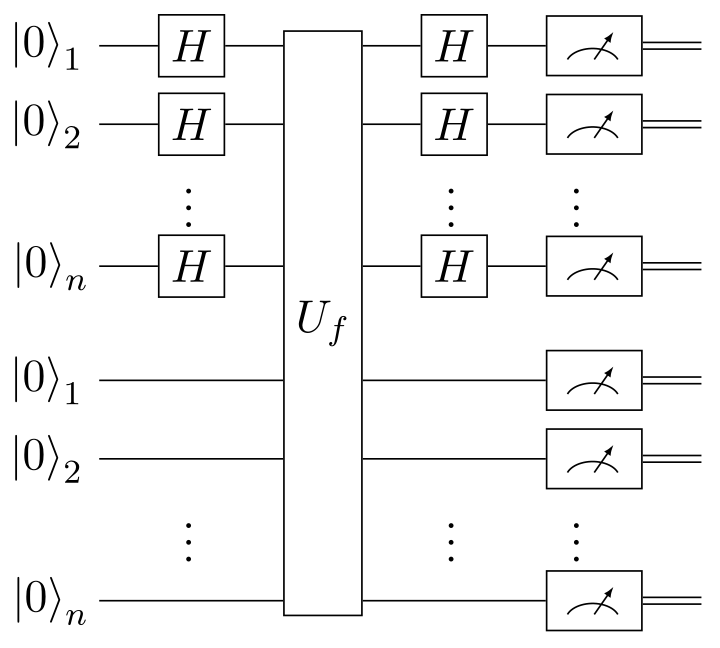Categories: Algorithms, Quantum information.
Simon’s algorithm
Simon’s algorithm was the first proof that quantum computers are able to solve some problems exponentially faster than classical computers. In the same spirit as the Deutsch-Jozsa algorithm and the Bernstein-Vazirani algorithm, the problem it solves, known as Simon’s problem, is of no practical use, but nevertheless Simon’s algorithm is an important milestone.
Simon’s problem is this: we are given a “black box” function that takes an -bit input and returns an -bit output. We are promised that there exists an such that for all and :
In other words, regardless of what does behind the scenes, its output is the same for inputs and if and only if , or, equivalently, .
The goal is to find the -bit number , using as few calls to as possible. There are two cases: if , then is one-to-one, since . Otherwise, if , then is two-to-one by definition: for every there exists exactly one such that .
A classical computer solves this by randomly guessing inputs, until it finds two that give the same output, and then . For -bit numbers, this takes guesses (the square root is due to the birthday paradox).
A quantum computer needs to query only times, although the exact number varies due to the algorithm’s probabilistic nature. It uses the following circuit:
The XOR oracle implements , and has the following action for -bit and :
Starting from the state , we apply the Hadamard gate to each of the first qubits:
Where is shorthand for . In other words, we now have an equal superposition of all possible inputs , with a constant beside it. We give this to the oracle :
Then we apply to the first qubits again, which, thanks to the definition of the Hadamard transform, yields the following, where is the bitwise dot product:
Next, we measure all qubits. The order in which we do this does not matter, but, for clarity, let us measure the last qubits first, yielding for some . Doing this leaves the qubits in the following state, where and :
If , we get an equal superposition of all , so when we measure the first qubits, the result is a uniformly random number, regardless of the phase .
If , we get an “extra superposition”, since but both are candidate inputs. This is a more interesting situation, because we can only measure -values where:
Since by definition, we can rewrite this as follows:
Clearly, this expression can only be nonzero if is even. In other words, when we measure the first qubits, we get a random -value, for which is guaranteed to be even.
In both cases and , measuring the first qubits gives a -value satisfying:
This tells us something about , albeit not much. But if we run Simon’s algorithm times, we get various -values , from which we can build a system of linear equations:
This can be solved efficiently by a classical computer. In the best-case scenario, all those -values would be linearly independent (when regarded as vectors of bits), in which case only equations would be necessary. Simon’s algorithm is therefore .
It may feel like “cheating” to use a classical computer at the end. Remember that the point of this algorithm is to limit the number of oracle queries, which we did successfully. Querying an oracle might be a very expensive operation, so that is a big improvement! That said, Simon’s algorithm currently has no known practical uses.
References
- J.S. Neergaard-Nielsen, Quantum information: lectures notes, 2021, unpublished.
- S. Aaronson, Introduction to quantum information science: lecture notes, 2018, unpublished.
